
An area drain inlet to the combined sewer system at Walgreen’s at Highland and Bardstown Road.
MSD only installing 19 green infrastructure projects that reduce its $ 34 million annual stormwater charge revenues.
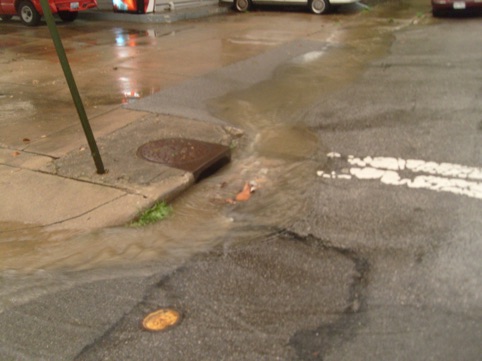
AREA DRAINS in a Combined Sewer city
MSD charges storm water fees to commercial businesses that have huge impervious (paved) parking lots. But private business owners with some exceptions have not been required to retrofit storm water capture and detention basins on older parking lots. Mid City Mall in the Highlands is an example, but is by no means, unique.
The problem with very large parking lots is heavy rains rapidly runoff to catch basins in the ground, that are connected to our old combined sewer and storm water collection pipes. The stormwater from large paved acreage can produce a heavy flow volume depending on the rain intensity and duration. This large volume of flow quickly fills up the sewer lines and triggers overflows of polluted water into Beargrass Creek. Using sewer atlas provided by MSD, its possible to determine where the stormwater from Mid City Mall contributes to sewer overflows to the channelized South Fork of Beargrass Creek.
1 acre is 6,272,640 square inches. One inch of rain on a paved acre that runs off 100% adds up to 27,154 gallons. That would fill 493.7, 55 gallon rain barrels.
The rain doesn’t run off 100% even from paved parking lots. The asphalt is wetted and the concrete may be somewhat porous and soak up some of the water. This can be figured in by using a runoff coefficient. So if the coefficient is complete runoff = 1, with no absorption. Concrete and asphalt parking lots as well as sealed roofs generally have a coefficient of .70 - .95, depending on cracks and age. Green engineering strategies use areas with low runoff coefficient values to soak up and hold in the stormwater. So the Calvary Cemetery acreage just south west of Mid City Mall has a grassy expanse with a high absorption rate or runoff coefficient of .10 - .25 depending on the total impervious area of roads and stones.
1 gallon X .25 coefficient = 1 quart, only a quart runs off.
A progressive, environmentally sound approach to dealing with the billions of gallons of combined sewer overflows that pollute Louisville streams and rivers, would be to aggressively install and retrofit storm water detention capacity on site at very large privately owned parking lots like the Mid City Mall. Even more progressive and environmentally sound, is to disconnect the storm water system from the combined sewer system so that storm water never flows into the combined sewer pipes to cause overflows.
If a large private multi-acre parking lot has a runoff coefficient of .95, that means most of its runoff ends up in pipes and catch basins. Such large stormwater runoff sources need to be prioritized for retrofit detention, and the slow emptying of the basin should be to green lawn areas for absorption, not into the sewer system that will have to mix it with sewage and treat the large volume with expensive solids removal processes and disinfection and de-odor chemicals.
However if you wanted to run a very large polluting MSD where you handled billions of rate payer dollars to make big engineering projects, you would want to build large concrete basins at the end of large pipes and build large treatment plants to treat millions of gallons of contaminated storm water instead of capturing it cheaply and removing it from the system permanently.

CSO 152 overflows to the
South Fork of Beargrass Creek at Schiller Avenue
Mid City Mall parking lot and roof drains through underground pipes to Baxter Avenue, then through 84 inch pipes under Calvary cemetery to CSO 152.
Courtesy Google Maps
84 inch sewer line
This is the discharge outlet for the large sewer overflow on the channelized part of South Fork of Beargrass Creek. The polluted sewer and storm water that overflows is sifted through the basket strainers that removes some toilet paper, leaves, bottles, cigarette butts, limbs and other litter and trash that is swept into area drains and street catch basins from Bardstown Road, Baxter Avenue and the major parking lots and roofs up pipe. Significant amounts of flow could be captured and removed by requiring rain barrels to be installed at house and garage down spouts, and by requiring big commercial parking lots to capture roof runoff in rain barrels and roof drain tanks and large capacity under parking lot tanks. In all cases, the tanks should discharge to green space, gardens and storm ditches instead of the combined sewer system.
The Baxter Avenue side of Mid City Mall is elevated above street level and a large capacity basin could be installed under the parking lot along Baxter and drain by gravity to storm drains under Baxter Avenue to Calvary Cemetery. To the extent these private entities would refuse to cooperate in the effort, MSD and city government should make it happen.

Mid City Mall is just one example of large paved areas not required by MSD to capture and remove storm water from the system
Courtesy Google Maps

Mid City Mall back lot slopes down towards Baxter Avenue and flows into area drains like this one.

Views of storm water on Baxter Avenue with significant flow from Mid City Mall
MSD’s Stormwater Rates
download the whole document at:
<http://www.msdlouky.org/insidemsd/rates.htm>
Class A properties or Single-Family Residential
The single-family residential charge rate shall be $6.46 per month for each parcel having one or two residential dwelling unit(s). This flat rate fee is based on each single-family residential parcel being equal to one equivalent service unit (ESU). MSD shall determine the number of single-family residential parcels in the drainage service area and designate each as a single ESU irrespective of the size of parcel is segregated or the use of the land is modified to other than single-family. Drainage Charges may be pro-rated based on the number of actual days in a billing cycle.
Class B or other Parcels
The charge for all other parcels within the drainage service area shall be based upon the number of square feet of measured impervious surface, as determined by MSD through aerial photography and surface feature evaluation processes, expressed in whole ESUs by rounding to the next highest ESU (an ESU has been determined to be 2,500 square feet of impervious surface). The charge for Class B property may be computed by multiplying the number of ESUs for a given parcel by the unit rate established by MSD of $6.46 per month. Drainage Charges may be pro-rated based on the number of actual days in a billing cycle. Any owner of Class B property may request a drainage charge credit adjustment for approved on-site stormwater retention or detention facilities provided:
-
1.The property owner remains responsible for all costs of operation and maintenance of the facility;
-
2.The facility has been constructed in accordance with all approved plans; “and drainage service charges” following the term “Wastewater Service Charges” whenever said term appears in said provision.
-
3.The owner has obtained MSD required permits for the facility; and
-
4.MSD has access to the facility for purposes of inspecting for compliance with design, maintenance and operating standards.
Green Management Practices (GMP) Manual
http://www.msdlouky.org/insidemsd/standard-drawings.htm
A new addition to the MSD Design Manual is Chapter 18, Green Management Practices (GMP) Manual. MSD is promoting GMPs to supplement traditional development and construction methods to encourage environmental sustainability and economic growth. Green infrastructure is a term commonly applied to stormwater GMPs such as pervious pavement, rain gardens and bioswales. These GMPs are designed to infiltrate rain water into the ground rather than it running into MSD’s combined sewers or the community’s waterways. The GMPs should be considered as a list of tools and should be implemented based on the site conditions and stormwater management needs to comply with Clean Water Act, post-construction stormwater water quality and quantity requirements.
“MSD believes the use of GMPs in urban watersheds will
reduce the downstream peak flow rates through urban
stream corridors during periods of wet weather and more
closely mimic natural, pre-development conditions. By
managing stormwater runoff pursuant to the process
outlined in Chapter 18.3, the volume of runoff entering
traditional gray infrastructure, drainageways and streams will
be reduced during wet weather, because the GMPs in this
manual promote retaining and infiltrating stormwater
runoff on site; and slowing and/or reducing runoff. The
base flow of streams can be increased, depending on the
GMP selected, and the infiltration capacity of in situ soils
and connectivity to the water table. Incorporation of GMPs
is recognized by MSD as a critical component in reducing
CSOs, MS4 program compliance and meeting flood control
objectives.”
The Green Management Practices Manual has many wonderful green engineering possible installations. The one on the right is large rainwater cisterns. Combinations of green engineering can be used to reduce or eliminate storm water runoff into the sewer and remove pollutants that storm water picks up moving across roads and parking lots.
MSD’s rate system charges big parking lots based of ESUs but offers recovery credits against rate payments for installed green engineering measures that remove storm water. These measures are still voluntary and have not been widely adopted. This great cheap way improve water quality is still waiting for widespread application.
Mid city roof drain to parking lot could be mitigated with a rainwater cistern and a rain garden box along the wall.
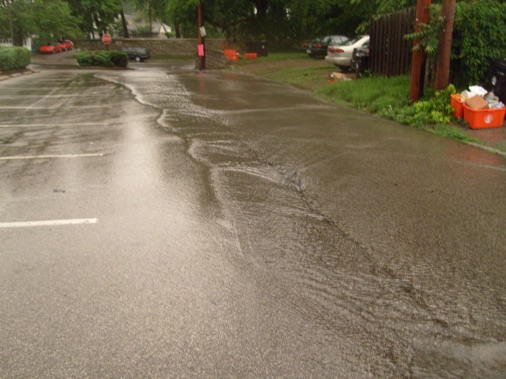
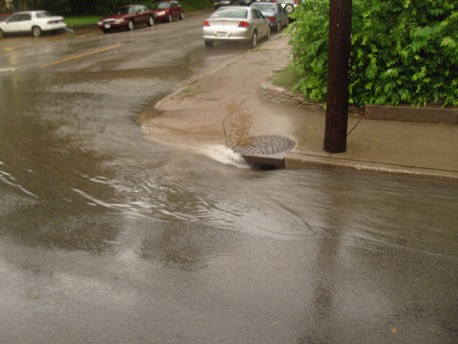
Credits-Monthly Drainage Service Credit
If MSD approves a drainage charge credit for on-site stormwater retention or detention facilities, the credit will be applied by reducing the number of billable ESUs by the percent of reduction in stormwater runoff due to such on-site facilities, as determined by MSD. The net billable ESUs after such credit is applied shall be expressed in whole ESUs by rounding to the next highest ESU. The adjusted drainage service charge shall not be less than 50% of the drainage service charge before the credit adjustment.
Applications for credits and stipends utilizing green infrastructure BMPs that exceed minimum requirements established by local ordinance and the MSD Design Manual will be reviewed to consider potential credit for peak flow rate reduction, total site runoff reduction, water quality benefit and green infrastructure outreach/education. The basis for the credit computation is as follows:
Credit Computation Basis
Stormwater/ Green Infrastructure Element
Percent of Credit
Peak Flow Rate
15%
Total Runoff
15%
Water Quality
15%
Green Infrastructure Education and Outreach
5%
Maximum 50% credit on Monthly Drainage Service Charge
Maximum 25% credit if Capitol Recovery Stipend is granted
Selected MSD Definitions
-
c.An “Equivalent Service Unit” (ESU) is the measure of impervious ground cover for a typical single-family residential property and is used by MSD in assessing the drainage service charges for each parcel of property.
-
d.“Impervious Surface” shall mean those hard surface areas either which prevent or retard the entry of water into the soil in the manner that such water entered the soil under natural conditions pre-existent to development, or which cause water to run off the surface in greater quantities or at an increase rate of flow than that present under natural conditions pre-existent to development, including, without limitations, such surfaces as roof tops, asphalt or concrete paving, driveways and parking lots, walkways, patio areas, storage areas, or other surfaces which similarly affect the natural infiltration or runoff patterns existing prior to development.
-
e.“Drainage Master Plan” shall mean the plan for managing storm drainage and surface water runoff facilities and features within MSD’s drainage service area and the drainage basins therein.
-
f.“Drainage Service Charge” means the fee levied by MSD upon all developed real property within the boundaries of MSD’s drainage service area as authorized by this amendment.
m. “Peak Flow Rate” shall be based on the following storm events: 3 month 24 hour; 1 year 24 hour; 5 year 24 hour; 100 year 24 hour;
n. “Stormwater Retention or Detention Facilities” shall mean stormwater drainage structures such as a basin, best management practice or facility that detains or retains (infiltrates) surface drainage / rainwater runoff;
o. “Total Runoff” shall be based on the following storm events: 3 month 24 hour; 1 year 24 hour; 5 year 24 hour; 100 year 24 hour;
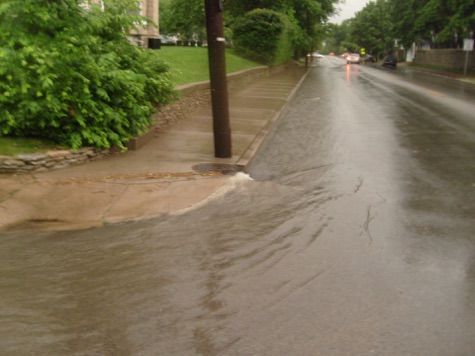
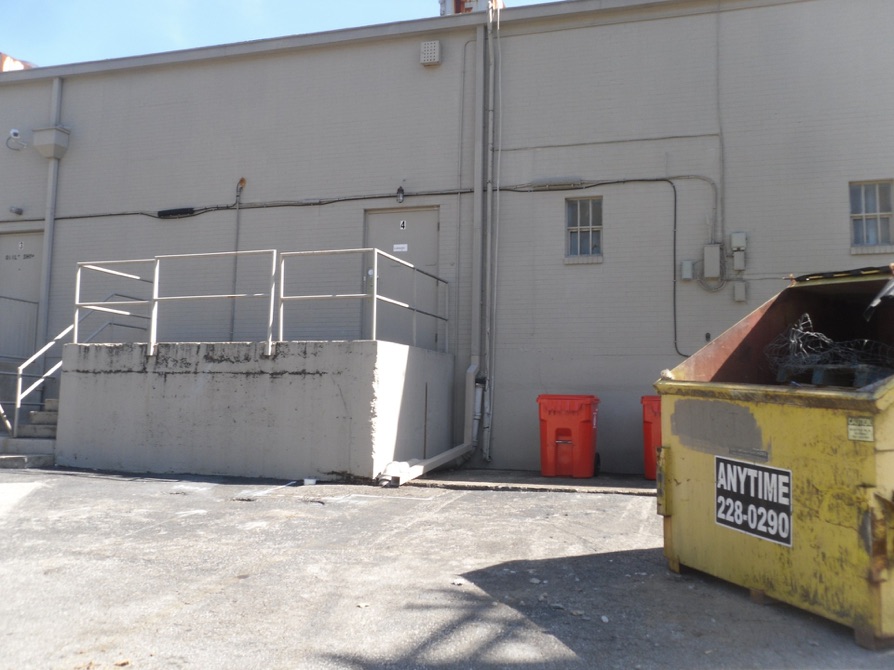
cemetery lots of green space. low runoff coefficient
paved parking lot high runoff coefficient, very little absorption

MSD REPORTED STORMWATER CHARGES
Values below are reported in thousands of dollars. 2010 stormwater charge revenue was $ 34.7 million dollars
2010 2009 2008 2007 2006 2005 2004 2003 2002
METRO ORDINANCE
§ 50.64 GRANT OF AUTHORITY OVER STORM AND SURFACE WATER DRAINAGE.
MSD is granted the authority to plan, acquire, improve, construct, develop, install, modify, manage, operate, maintain, repair, replace, control, demolish, abandon, regulate, employ and fund public flood control and storm and surface water systems within the district and drainage service area, personnel, equipment and facilities and associated services and activities necessary for the collection, control, treatment and disposal of storm and surface water in a safe, proper and efficient manner and is granted the authority to fund flood control and storm and surface water services, systems and facilities by fixing rates, fees and charges throughout the district area and drainage service area as herein elsewhere provided.
Page 4
MSD Comprehensive Annual Financial Report (“CAFR”)
for the fiscal year ended June 30, 2010 (“2010”)
“As part of its consent decree, MSD committed to implementing Green Infrastructure demonstration projects at 19 locations within the Louisville Metro area during the next two calendar years. The Integrated Overflow Abatement Plan (IOAP) requires that 12 of the projects be finished in calendar year 2010. A study summarizing the business case value
of green initiatives was developed as part of the IOAP. It assigned a value per unit of installed green practice to MSD, which is based on the reduction of overflows, decreased plant flows and the “right sizing” of IOAP gray projects. Planned green infrastructure projects will be evaluated for determining the total benefit received by MSD and the community based on the size of various technologies used. MSD believes that green infrastructure projects will be as effective as traditional concrete or “gray” infrastructure projects but they can be constructed at a lower cost.”

The Green Building on Market Street is equipped with rain water capture tanks to use for rain garden
Mid City Mall is in the stone age of stormwater runoff green infrastructure
MSD has installed a green infrastructure project downtown at the parking lot at 6th and Cedar.
The strategy for the IOAP is to build a few demonstration green infrastructure projects and go around crowing how green MSD is.
Otherwise, MSD does not push an ordinance to require Class B properties to adopt green infrastructure measures that would stop sewer overflows and avoid spending millions of dollars of public funds on big environmentally damaging and high maintenance sewer overflow basins like the one planned at Lexington Road. See it
MSD plans to build nearly $ 800 million worth of sewer overflow abatement projects, and THEN look at opportunities to reduce sewer overflows by adopting green infrastructure projects. MSD is using the IOAP as an excuse to build huge engineering projects while at the same time expanding the sewer collections system by large percent.
Green infrastructures could be mandated by a Metro adopted ordinance that would require private commercial property owners to phase in increasing storm water control measures to divert rain fall into gardens and absorbing soils instead or contributing to the polluting stormwater combined sewer overflow pollution problem.
Don’t look for anyone at MSD or Metro government to start pushing a mandatory green infrastructure program. Metro ordinances establish MSD as the storm water authority and establish a lucrative stormwater revenue stream coming into MSD.
Letting MSD build giant projects means more valuable infrastructure listed as assets on the balance sheet, requires more engineering contracts and maintenance jobs. The combined sewer overflow program has become an overextended and prolonged agony from which major agencies collect and spend millions of rate payer dollars annually.
curb cuts on the 6th and Cedar project
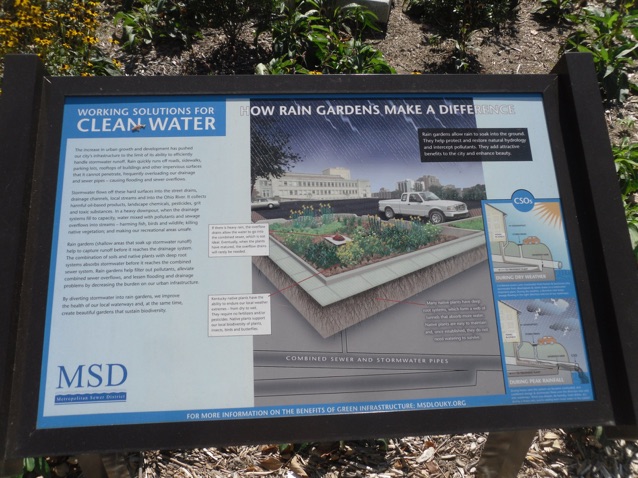
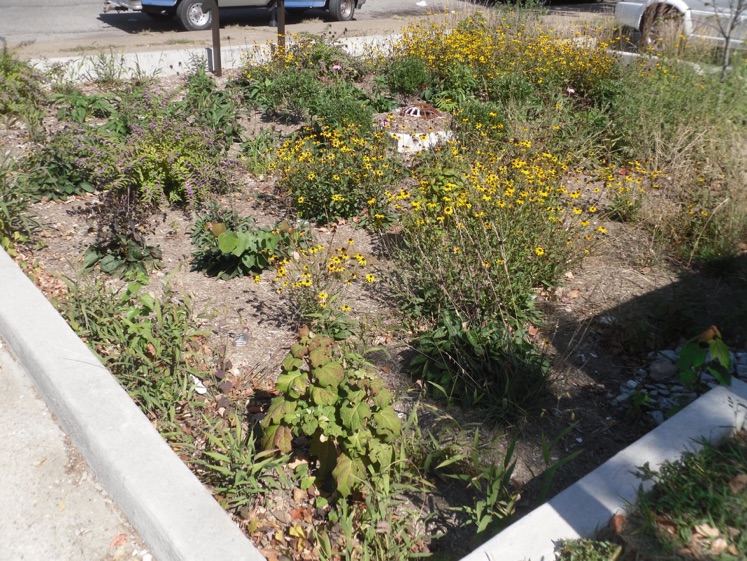


MSD website has more information on these big projects all sized with a flawed computer model. MSD told me that the $ 12,950,000 million dollar I-64 at Grinstead Drive basin would now cost $ 30 million and have to hold 12 million gallons instead of the originally projected 2.74 million gallons because the actual flow results showed the computer modeled flow used to project basin capacity requirements was more than 50 % wrong. If this is the case, the 2009 projected cost of these 13 concrete basins based on wrong size projections could more than double.
Integrated Overflow Abatement Plan
Final CSO Long-term Control Plan
List of Gray Infrastructure Projects - basins
150,000 not basin – in line storage
315,000 CSO 123 downspout disconnection
938,000 Adams Street storage basin
+ 1,580,000 Story Ave and Main Street basin
+ 3,842,000 CSO 206 sewer separation
+ 24,940,000 Paddys Run wet weather treatent facility
+ 12,950,000 I-64 & Grinstead basin (now $ 30 million)
+ 1,361,000 CSO 58 sewer separation
+ 3,150,000 CSO 140 Sewer separation
+ 952,000 CSO 93 sewer separation
+ 237,000 CSO 160 sewer separation
+ 15,710,000 Nightingale pump station expansion
+ 1,077,000 Story Avenue at Spring basin
+ 30,320,000 Logan at Breckinridge Street basin
+ 13,720,000 Calvary at Creekside basin
+ 4,514,000 18th at Northwestern basin
+ 12,994,000 New Beargrass Creek interceptor trunk line to Buthchertown
+ 13,870,000 Clifton Heights basin
+ 17,300,000 Algonquin pkwy basin
+ 17,620,000 Southwestern Pkwy basin
+ 20,000,000 Portland Wharf basin
+ 49,680,000 13th and Rowan basin
-
+ 25,200,000 Lexington Road at Payne Street basin
Total
$ 272,420,000
$ 208,769,000 for 64.2 million gallons of
storage in basins
thats paying $ 3,252 million dollars per each million
gallons of storage of dirty water that has to be
expensively treated at the treatment plant when
the basins empty back to the sewer system every
time they fill up.
There is no one in Louisville that is independently
truth checking this IOAP plan to spend $ 208 million
on big engineering projects, which may balloon to
twice that expense and commit our city to years of
big treatment bills that could be reduced by simply
requiring a more extensive on site storm water
capture plan.
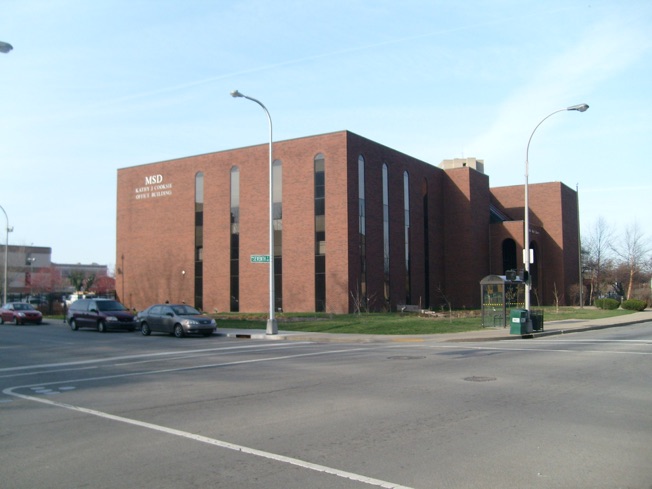

Heavy rain on 7-19-2012 at the
Mid City Mall parking lot on
Baxter Avenue

Heavy rain on 7-19-2012 forms a sheet flow past the back side of Mid City Mall flowing to Baxter Avenue

Heavy stormwater runoff on 7-19-2012 flows to Baxter Avenue and toward the combined sewers outfall CSO 152
Prior to urban development there would have been intermittent streams flowing from the high ground where Mid City Mall is located to the South Fork of Beargrass Creek. These features were bulldozed and filled in past decades before green infrastructure development practices were considered
With more and more development the stormwater has less area to infiltrate and absorb into the soil. This stormwater problem could be alleviated with rain garden installations on the Mid City property combined with temporary detention structures. In winter the water collects and freezes into a dangerous ice sheet.

Carp swimming in the heavily polluted Beargrass Creek Middle Fork



View from the Winter Avenue bridge during a heavy downpour on September 4th, 2012.

